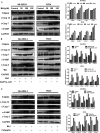Ginsenoside Rk1 inhibits cell proliferation and promotes apoptosis in lung squamous cell carcinoma by calcium signaling pathway
- PMID: 35528653
- PMCID: PMC9069870
- DOI: 10.1039/c9ra05037j
Ginsenoside Rk1 inhibits cell proliferation and promotes apoptosis in lung squamous cell carcinoma by calcium signaling pathway
Abstract
Ginsenoside Rk1 (Rk1) is a rare saponin extracted from Sun Ginseng (SG) and has been shown to have an anti-tumor effect; however, the potential role of its in lung squamous cell carcinoma remains elusive. In this study, we investigated the anti-proliferative activity and involved mechanism of Rk1 against lung squamous cell carcinoma in vitro and in vivo. First, MTT assay, cell colony formation assay and cell cycle assay showed that Rk1 effectively inhibited cell proliferation and colony formation, and induced cell arrest at G1 phase. Following AV/PI staining, JC-10 staining, Western blot and immunohistochemistry indicated that Rk1 induced caspase-dependent apoptosis. In addition, Rk1 induced ER stress, causing the release of Ca2+, resulting in intracellular calcium and mitochondrial calcium overload. Intracellular calcium overload activated the calpain-caspase-12 and calpain-caspase-7-PARP pathways, while mitochondrial calcium overload caused mitochondrial membrane potential reduced, and the release of cytochrome c. BAPTA-AM (Ca2+ scavengers) and calpeptin (calpain inhibitors) significantly attenuated Rk1-induced apoptosis. Moreover, Rk1 significantly inhibited the growth of SK-MES-1 xenograft tumors with low toxic side effects. In summary, this study for the first time demonstrated that Rk1 had significant antitumor effects against lung squamous cell carcinoma and great potential to serve as a novel anticancer agent.
This journal is © The Royal Society of Chemistry.
Conflict of interest statement
The authors declare that they have no competing interests.
Figures








Similar articles
-
Ginsenoside Rk1 induces cell cycle arrest and apoptosis in MDA-MB-231 triple negative breast cancer cells.Toxicology. 2019 Apr 15;418:22-31. doi: 10.1016/j.tox.2019.02.010. Epub 2019 Feb 21. Toxicology. 2019. PMID: 30797898
-
Ginsenoside Rk1 induces apoptosis and downregulates the expression of PD-L1 by targeting the NF-κB pathway in lung adenocarcinoma.Food Funct. 2020 Jan 29;11(1):456-471. doi: 10.1039/c9fo02166c. Food Funct. 2020. PMID: 31830168
-
Ginsenoside Rk1 inhibits HeLa cell proliferation through an endoplasmic reticulum signaling pathway.J Ginseng Res. 2023 Sep;47(5):645-653. doi: 10.1016/j.jgr.2023.04.004. Epub 2023 Apr 14. J Ginseng Res. 2023. PMID: 37720575 Free PMC article.
-
Ginsenoside Rk1 Induces Apoptosis in Neuroblastoma Cells Through Loss of Mitochondrial Membrane Potential and Activation of Caspases.Int J Mol Sci. 2019 Mar 11;20(5):1213. doi: 10.3390/ijms20051213. Int J Mol Sci. 2019. PMID: 30862004 Free PMC article.
-
The Anti-Tumor Effect and Underlying Apoptotic Mechanism of Ginsenoside Rk1 and Rg5 in Human Liver Cancer Cells.Molecules. 2021 Jun 27;26(13):3926. doi: 10.3390/molecules26133926. Molecules. 2021. PMID: 34199025 Free PMC article.
Cited by
-
Ginsenoside RK1 Induces Ferroptosis in Hepatocellular Carcinoma Cells through an FSP1-Dependent Pathway.Pharmaceuticals (Basel). 2024 Jul 2;17(7):871. doi: 10.3390/ph17070871. Pharmaceuticals (Basel). 2024. PMID: 39065721 Free PMC article.
-
Mitochondrial dysfunction in heart diseases: Potential therapeutic effects of Panax ginseng.Front Pharmacol. 2023 Jul 20;14:1218803. doi: 10.3389/fphar.2023.1218803. eCollection 2023. Front Pharmacol. 2023. PMID: 37547332 Free PMC article. Review.
-
Therapeutic Applications of Ginseng Natural Compounds for Health Management.Int J Mol Sci. 2023 Dec 9;24(24):17290. doi: 10.3390/ijms242417290. Int J Mol Sci. 2023. PMID: 38139116 Free PMC article. Review.
-
Role of PD-1/PD-L1 signaling axis in oncogenesis and its targeting by bioactive natural compounds for cancer immunotherapy.Mil Med Res. 2024 Dec 18;11(1):82. doi: 10.1186/s40779-024-00586-9. Mil Med Res. 2024. PMID: 39690423 Free PMC article. Review.
-
A Review of the Therapeutic Potential of Ginseng and Its Bioactive Components in Nonalcoholic Fatty Liver Disease.Drug Des Devel Ther. 2025 Jan 8;19:83-96. doi: 10.2147/DDDT.S500719. eCollection 2025. Drug Des Devel Ther. 2025. PMID: 39803604 Free PMC article. Review.
References
-
- Yan L. Yao Y. Wang L. H. Wang M. L. Fu X. H. Detection of CK19, LUNX, and KS1/4 mRNA expression in the peripheral blood for diagnosis of micrometastases in patients with non-small cell lung cancer and their clinical implications. Genet. Mol. Res. 2015;14:15090–15095. doi: 10.4238/2015.November.24.17. - DOI - PubMed
-
- Scagliotti G. V., Novello S., Rapetti S. and Papotti M., Current State-of-the-Art Therapy for Advanced Squamous Cell Lung Cancer, American Society of Clinical Oncology Educational Book, 2013, vol. 354 - PubMed
LinkOut - more resources
Full Text Sources
Research Materials
Miscellaneous

